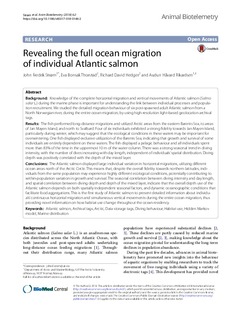| dc.contributor.author | Strøm, John Fredrik | |
| dc.contributor.author | Thorstad, Eva Bonsak | |
| dc.contributor.author | Hedger, Richard David | |
| dc.contributor.author | Rikardsen, Audun H. | |
| dc.date.accessioned | 2018-03-08T12:43:28Z | |
| dc.date.available | 2018-03-08T12:43:28Z | |
| dc.date.created | 2018-02-16T08:31:45Z | |
| dc.date.issued | 2018 | |
| dc.identifier.issn | 2050-3385 | |
| dc.identifier.uri | http://hdl.handle.net/11250/2489510 | |
| dc.description.abstract | Knowledge of the complete horizontal migration and vertical movements of Atlantic salmon (Salmo salar L.) during the marine phase is important for understanding the link between individual processes and population recruitment. We studied the detailed migration behaviour of six post-spawned adult Atlantic salmon from a North Norwegian river, during the entire ocean migration, by using high-resolution light-based geolocation archival tags. The fish performed long-distance migrations and utilized Arctic areas from the eastern Barents Sea, to areas of Jan Mayen Island, and north to Svalbard. Four of six individuals exhibited a strong fidelity towards Jan Mayen Island, particularly during winter, which may suggest that the ecological conditions in these waters may be important for overwintering. One fish displayed exclusive utilization of the Barents Sea, indicating that growth and survival of some individuals are entirely dependent on these waters. The fish displayed a pelagic behaviour and all individuals spent more than 83% of the time in the uppermost 10 m of the water column. There was a strong seasonal trend in diving intensity, with the number of dives increasing with day length, independent of individuals’ spatial distribution. Diving depth was positively correlated with the depth of the mixed layer. The Atlantic salmon displayed large individual variation in horizontal migrations, utilizing different ocean areas north of the Arctic Circle. This means that, despite the overall fidelity towards northern latitudes, individuals from the same population may experience highly different ecological conditions, potentially contributing to within-population variation in growth and survival. The seasonal correlation between diving intensity and day length, and spatial correlation between diving depth and depth of the mixed layer, indicate that the overall depth use of the Atlantic salmon depends on both spatially independent seasonal factors, and dynamic oceanographic conditions that facilitate food aggregations. This is the first study of Atlantic salmon to present detailed information about individuals’ continuous horizontal migration and simultaneous vertical movements during the entire ocean migration, thus providing novel information on how habitat use change throughout the ocean residency. Atlantic salmon, Archival tags, Arctic, Data storage tags, Diving behaviour, Habitat use, Hidden Markov model, Marine distribution | nb_NO |
| dc.language.iso | eng | nb_NO |
| dc.rights | Navngivelse 4.0 Internasjonal | * |
| dc.rights.uri | http://creativecommons.org/licenses/by/4.0/deed.no | * |
| dc.title | Revealing the full ocean migration of individual Atlantic salmon | nb_NO |
| dc.type | Journal article | nb_NO |
| dc.type | Peer reviewed | nb_NO |
| dc.description.version | publishedVersion | nb_NO |
| dc.subject.nsi | VDP::Zoologiske og botaniske fag: 480 | nb_NO |
| dc.subject.nsi | VDP::Zoology and botany: 480 | nb_NO |
| dc.source.volume | 6 | nb_NO |
| dc.source.journal | Animal Biotelemetry | nb_NO |
| dc.source.issue | 2 | nb_NO |
| dc.identifier.doi | 10.1186/s40317-018-0146-2 | |
| dc.identifier.cristin | 1565788 | |
| dc.relation.project | Egen institusjon: The University of Tromsø | nb_NO |
| dc.relation.project | Tromsø forskningsstiftelse: The Salmotrack project (2008–2017), | nb_NO |
| dc.relation.project | Norges forskningsråd: 221400 | nb_NO |
| dc.relation.project | Andre: Alta Laksefiskeri Interessentskap | nb_NO |
| cristin.unitcode | 7511,3,0,0 | |
| cristin.unitname | Avdeling for akvatisk økologi | |
| cristin.ispublished | true | |
| cristin.fulltext | original | |
| cristin.qualitycode | 1 | |

